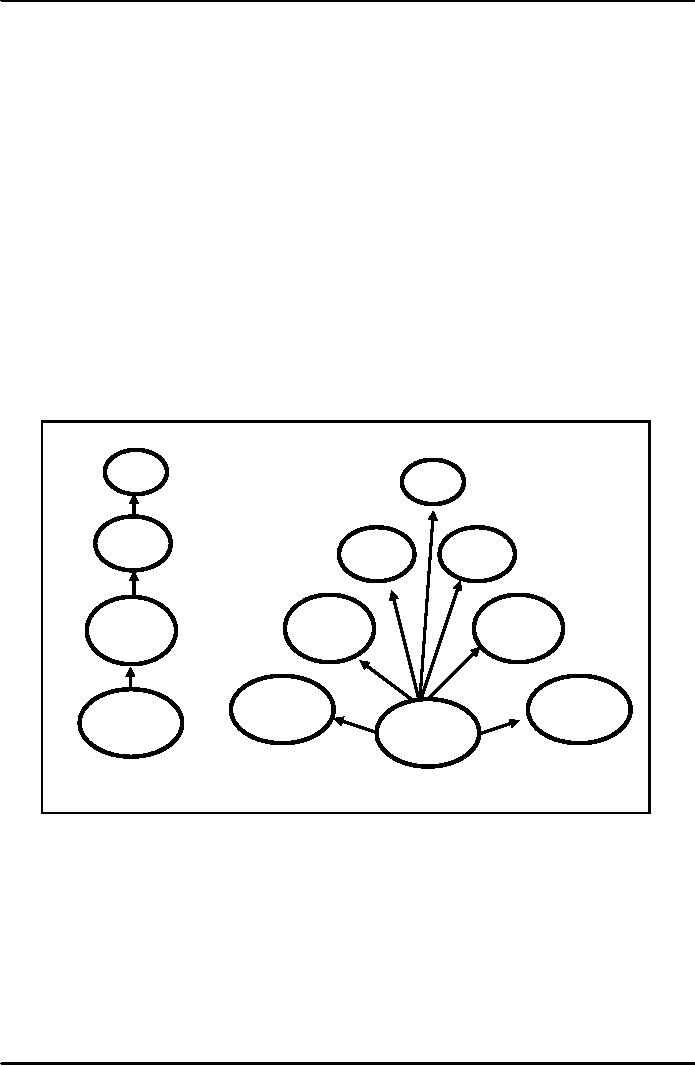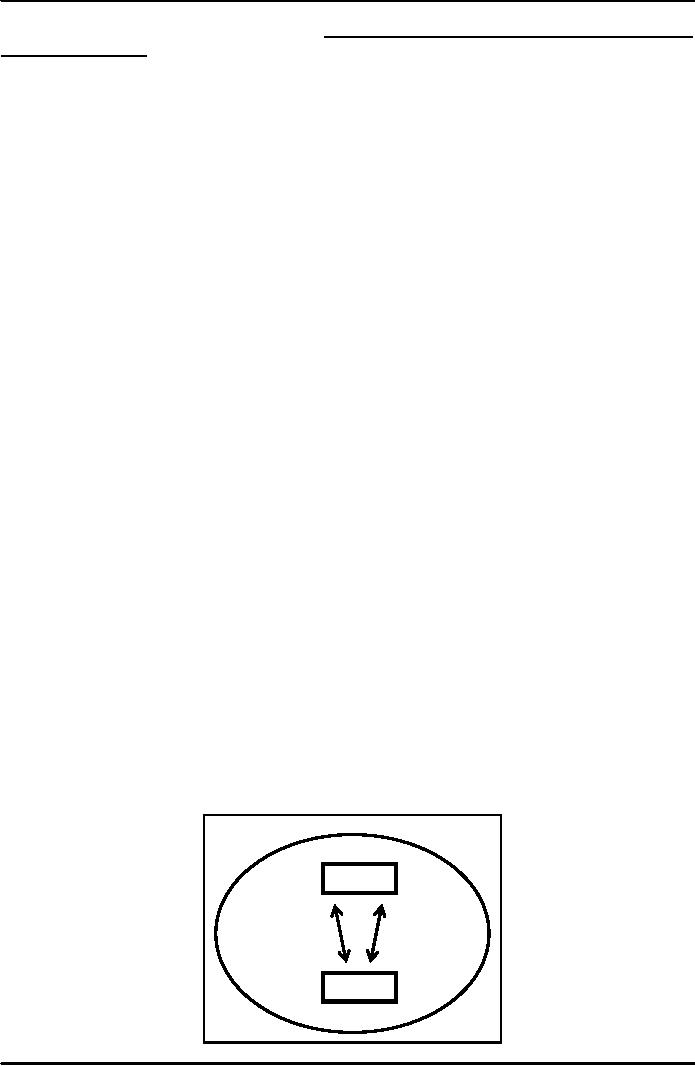 |

Introduction
To Public
AdministrationMGT111
VU
LESSON
38
COMMUNICATION
II
At the
end of the lecture students
will be able to:
-
Understand
the factors in organizational communication;
-
Understand
the use of communication in negotiation
and
-
Summarizing
the concepts in communication.
Factors
in Organizational
Communication
As
we know organizations have
structure and within this
structure are roles and
relationships
between
and amongst roles, communication in
organizational structure follows a
system. Communication
within
organization flows along the structure of
organization. These are called
formal
channels of
communication.
Formal
channels of communication influence communication in
two ways: one, the
size
of
organization i.e., the larger the size of
organization, longer it will take for
communication to reach the
bottom
of organization. Second, the formal
channels of communication can inhibit the
free flow of
information
between organizational levels and
horizontal level.
Other
factors that influence organizational communication
are discussed below:
1.
Authority Structure
Organization's
authority structure is the structure
that shows the amount of authority a
particular
position
has. Authority has influence on
communication. Status and power
differences in the organization
help
determine who will
communicate comfortably with whom. If the
communication takes place
between
senior
and subordinate, senior will
communicate comfortably with subordinate.
But subordinate may not
be
able
to do so. The content and
accuracy of the communication will also
be affected by authority
relationship.
2.
Job Specialization
Job
specialization refers to specialized
areas in which employees
work. For example doctor
will
communicate
well with doctor. So communication
within differentiated groups is
easy. Members of the
same
work group are likely to
share the same jargon, goals,
tasks, and personal styles.
Communication
between
highly differentiated (specialized)
groups, however, is likely to be
inhibited or difficult. For
example
communication
between doctor and
engineers.
3.
Information Ownership
The
term information ownership means that
individuals possess unique information
and
knowledge
about their jobs. For
example, a darkroom employee
may have found a particularly
efficient way
to
develop photo prints. So this information
belongs to this employee and he
may not share this
information
with others.
Problems
Since
organizational communication has to follow
through organizational structure it is
likely to be
filtered
or halted at each level as managers
decide what information should be passed
down to employees
and
what information to be kept at the top.
Similarly employee may not
give all information to
mangers
(Upward
communication). It is likely to be filtered by
middle level managers, who see
part of their job to
protect
upper management from unpleasant
information from below to be
passed upwards.
We
have just mentioned that
information from top down
and from bottom up is
filtered. What is
this
flow of communication called and
for what purpose it is used.
Communication from top-down
and
bottom-up
is called vertical
communication and
communication that flows horizontally
between same
levels
of employees in organization is called
lateral
communication.
Vertical
Communication
It
consists of communication up and down the
organization's chain of command. The
major
purposes
of downward communication are to advise,
inform, direct, instruct, and evaluate
employees and to
135

Introduction
To Public
AdministrationMGT111
VU
provide
organization members with information
about organizational goals, objectives
and policies. The
communication
from down-up is usually used
for problem solving, grievance
handling and maintaining
harmony
amongst employee and to
determine the performance of
employees.
Lateral
and Informal Communication
Lateral
communication usually follows the pattern of
work flow in an organization,
occurring
between
members of work groups,
between one work group
and another, between members
of different
departments,
and between line and staff
employees.
The
main purpose of lateral communication is
to provide a direct channel for
organizational
coordination
and problem solving. So, it
avoids the much slower
procedure of directing
communications
through
the chain of command. The
benefit of lateral communication is that
it enables organization
members
to form relationships with their
peers.
One
type of informal communication is the grapevine.
The grapevine within
organizations is made
up
of several informal communication networks
that overlap and intersect at a number of
points-that is,
some
well-informed individuals are
likely to belong to more than
one informal network. Figure 2
shows two
types
of grapevine or informal communication . In the
situation I person A spreads
information to
B,C,D,E,F,G
and H. Now each one
may perceive information
according to their
understanding.
Grape
Vine
Figure
1
D
F
C
E
D
G
C
B
H
B
A
A
Single
Strand II
Gossip
I
In
situation II information flows from A to
B, from B to C and from C to D.
When information is
passed
from one person to other
verbally it is called informal or
grape vine communication. This type
of
communication
has certain disadvantage. e. g.
some confidential information
can leak out which
may hurt
organization
objectives.
Using
Communication Skills
We
each must deal with
conflict in our personal
lives and organizational activities.
Conflict involves
a
disagreement about the allocation of
scarce resources or a clash of
goals, statuses, values,
perceptions, or
personalities.
Much of the conflict we experience
arises from our
communication.
Sometimes
we communicate clearly, but
sometime we don't. But clear
communication is essential
part
of organizational and life in general
i.e., that the message must
be put across clearly. Lack of clarity
in
136

Introduction
To Public
AdministrationMGT111
VU
communication
can lead to conflict.
Negotiation can help us
manage conflicts of all types in
more effective
and
mutually satisfying way.
What is negotiation? Negotiation is a
process by which two parties
interact to
resolve
conflict jointly.
Negotiating
To Manage Conflicts
Daily
life offers countless
examples of negotiation. We negotiate
with parents when we ask them
to
allow
us to go on a tour with friends. We
negotiate with friends about which
recreational activities to
pursue.
We negotiate with our boss
about working hour and
conditions. According to Lewicki and
Litterer,
all
these "negotiation situations"
are defined by three
characteristics. These
are:
1.
There is a conflict of interest between
two or more parties; that
is, what one wants is
not
necessarily
what the other one
wants.
2.
There is no fixed or established
set of rules or procedures
for resolving the conflict, or the
parties
prefer to work outside of a
set of rules and procedures
to invent their own solution
to
the
conflict.
3.
The parties, at least for
the moment, prefer to search for
agreement rather than to
fight
Many
factors are important to
successful negotiating. The actual
negotiation process depends
on:
1.
whether the
parties see their interests
as depending on each other
2.
The
extent of trust or distrust between the
parties;
3.
Each
party's ability to communicate
clearly and to persuade or
coerce the other party to
accept
its
point of view;
4.
The personalities and
idiosyncrasies of the actual people
involved; and
5.
The goals and
interests of the parties.
Guidelines
for Negotiations
For
negotiations to be successful managers
must keep in view the
following:
1.
Have
a set of clear objectives on
every bargaining item;
2.
Do
not hurry;
3.
Be
well prepared with
data;
4.
Maintain
flexibility in your
position;
5.
Be
a good listener
To
sum up negotiations help reduce
conflict and creates harmony in
relationship. Communication
acts
as the thread that makes negotiations
successful.
Interlink
age.
Motivation,
Leadership, teamwork Communication and
Negotiation complement each
other. A
leader
requires all these skills
which help him to keep
team together. Figure 2 illustrates this
relationship.
Interrelationship
of Communication and Managerial
functions.
Figure
2
Team
Motivate
Communicate
Leader
137

Introduction
To Public
AdministrationMGT111
VU
Concepts
Authority
structure:
Hierarchical
structure of organization wherein each level
and
position
has authority to get work
done.
Differentiation:
It
is job specialization where in
each job is different from
other
with
respect to its
specialization.
Information
ownership:
Each
employee according to the position
he/she is holding has
some
information/knowledge related to the
job.
Negotiation:
Process
by which two parties resolve
conflict jointly and
both
parties
get something in
return.
138
Table of Contents:
- INTRODUCTION:Institutions of State, Individualism
- EVOLUTION OF PUBLIC ADMINISTRATION:Classical School, The Shovelling Experiment
- CLASSICAL SCHOOL OF THOUGHTS – I:Theory of Bureaucracy, Human Relation Approach
- CLASSICAL SCHOOL OF THOUGHTS – II:Contributors of This Approach
- HUMAN RELATIONS SCHOOLS:Behavioural School, System Schools
- POWER AND POLITICS:Conflict- as Positive and Negative, Reactions of Managers, Three Dimensional Typology
- HISTORY OF PUBLIC ADMINISTRATION – I:Moghul Period, British Period
- HISTORY OF PUBLIC ADMINISTRATION – II
- CIVIL SERVICE:What are the Functions Performed by the Government?
- CIVIL SERVICE REFORMS:Implementation of the Reforms, Categories of the Civil Service
- 1973 CONSTITUTION OF PAKISTAN:The Republic of Pakistan, Definition of the State
- STRUCTURE OF GOVERNMENT:Rules of Business, Conclusion
- PUBLIC AND PRIVATE ADMINISTRATION:The Public Interest, Ambiguity, Less Efficient
- ORGANIZATION:Formal Organizations, Departmentalization
- DEPARTMENTALIZATION:Departmentalization by Enterprise Function, Departments by Product
- POWER AND AUTHORITY:Nature of Relationship, Delegation of Functional Authority
- DELEGATION OF AUTHORITY:The Art of Delegation, Coordination
- PLANNING – I:Four Major Aspects of Planning, Types of Plans
- PLANNING – II:Planning ProcessThree principles of plans
- PLANNING COMMISSION AND PLANNING DEVELOPMENT:Functions, Approval Authority
- DECISION MAKING:Theories on Decision Making, Steps in Rational Decision Making
- HUMAN RESOURCE MANAGEMENT (HRM):Importance of Human Resource, Recruitment
- SELECTION PROCESS AND TRAINING:Levels at Which Selection takes Place, Training and Development
- PERFORMANCE APPRAISAL:Formal Appraisals, Informal Appraisals
- SELECTION AND TRAINING AND PUBLIC ORGANIZATIONS:Performance Evaluation,
- PUBLIC FINANCE:Background, Components of Public Finance, Dissimilarities
- BUDGET:Components of Public Income, Use of Taxes, Types of Taxation
- PUBLIC BUDGET:Incremental Budget, Annual Budget Statement, Budget Preparation
- NATIONAL FINANCE COMMISSION:Fiscal Federalism Defined, Multiple Criteria
- ADMINISTRATIVE CONTROL:Types of Accountability, Internal Control, External Control
- AUDIT:Economy, Effectiveness, Objectives of Performance Audit, Concepts
- MOTIVATION:Assumptions about Motivation, Early ViewsThree Needs
- MOTIVATION AND LEADERSHIP:Reinforcement Theory, Leadership, The Trait Approach
- LEADERSHIP:Contingency Approaches, Personal Characteristics of Employees
- TEAM – I:Formal & Informal teams, Functions of Informal Groups, Characteristics of Teams
- TEAM – II:Team Cohesiveness, Four ways to Cohesiveness, Communication
- COMMUNICATION – I:Types of Communication, How to Improve Communication
- COMMUNICATION – II:Factors in Organizational Communication, Negotiating To Manage Conflicts
- DISTRICT ADMINISTRATION:The British Period, After Independence, The Issues
- DEVOLUTION PLAN – I:Country Information, Tiers or Level of Government
- DEVOLUTION PLAN – II:Aim of Devolution Plan, Administrative Reforms, Separation of powers
- POLITICAL REFORMS:District, Tehsil, Functions of Union Council, Fiscal Reforms
- NEW PUBLIC MANAGEMENT (NPM):Strategy, Beginning of Management Approach
- MANAGERIAL PROGRAMME AGENDA – I
- MANAGERIAL PROGRAMME AGENDA – II:Theoretical Bases of Management, Critique on Management